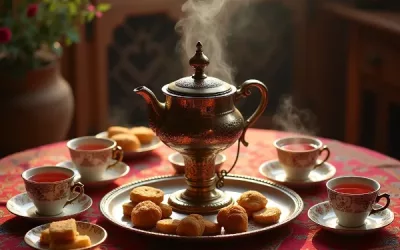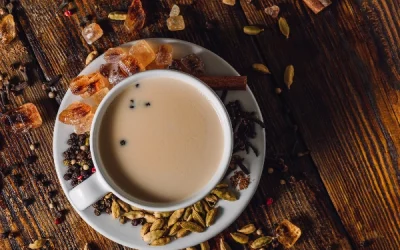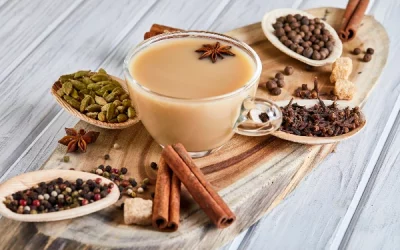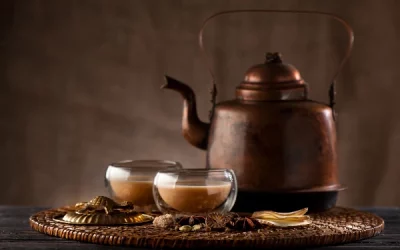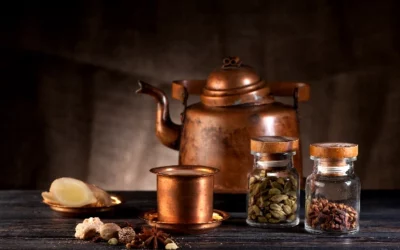Are you ready to elevate your home brewing game? In this article, I will guide you through mastering the perfect chai tea recipe, sharing essential tips, scrumptious variations, and intriguing nutritional insights. From choosing the right black tea to experimenting with spices, you’ll find everything you need to create that fragrant, comforting cup of chai. Whether you’re yearning for a traditional blend or exploring dairy-free options, I promise there’s something here for everyone. So grab your spices and let’s transform your chai tea experience together!
Table of Content
- What are the essential ingredients for a chai tea recipe?
- How do you prepare the perfect chai tea at home?
- What are some variations of the traditional chai tea recipe?
- What is the nutritional information of chai tea?
- How can you adjust the chai tea recipe for different tastes and dietary needs?
- What are some common mistakes to avoid when making chai tea?
- How does the cultural significance of chai tea influence its preparation and consumption?
- What are the health benefits of drinking chai tea?
- Conclusion
What are the essential ingredients for a chai tea recipe?
A traditional chai tea recipe brings together the rich flavours of black tea, milk, and a variety of aromatic spices. The essence of chai lies in the balancing act between these ingredients, creating a warm, comforting drink that is a staple in many cultures, particularly in India. In this section, we’ll discuss the necessary components of an authentic chai tea recipe, shedding light on how each ingredient contributes to this delightful beverage.
To make traditional chai at home, you’ll need a few key ingredients that define its unique taste and aroma. Each of these components plays an essential role in creating the perfect cup of chai, from the base of strong black tea to the sweet touch of sugar, and the spices that add depth.
What type of black tea is best for chai tea?
When choosing black tea for chai, opt for a robust variety that can hold its own against the strong spices and milk. Assam tea, known for its bold and malty flavour, is an excellent choice.
- Assam tea is robust and malty
- Can substitute with Ceylon tea for lighter taste
- Avoid delicate teas (like Darjeeling) as they can get overshadowed
- Use loose-leaf tea for more intense flavour
- Adjust quantity depending on desired strength
The strength and body of Assam tea provide a sturdy foundation for chai, ensuring the final brew is rich and full-flavoured. Loose-leaf tea tends to yield a more intense and aromatic cup compared to tea bags, although both can work in a pinch.
How do the spices enhance the flavour of chai tea?
The combination of spices is what truly sets chai apart from regular black tea. These spices not only enhance the flavour but also give chai its signature warming qualities.
- Cinnamon adds sweetness and warmth
- Ginger offers a spicy kick
- Cardamom brings a citrusy, floral note
- Cloves add depth and a bit of bitterness
- Star anise introduces a mild licorice flavour
Each spice contributes a unique element to chai. Cinnamon’s sweetness counterbalances the robustness of black tea, while ginger’s heat invigorates the palate. Cardamom’s bright notes add complexity, and the cloves and star anise further deepen the flavour profile.
Can alternative sweeteners be used in place of sugar?
Yes, various sweeteners can be substituted for sugar in chai. These alternatives can cater to different dietary needs and flavour preferences.
- Honey for a floral and smooth sweetness
- Maple syrup adds a rich, distinct taste
- Agave nectar is a vegan-friendly option
- Stevia for a calorie-free sweetener
- Coconut sugar for a slightly caramel-like flavour
These sweeteners not only modify the sweetness but can also introduce subtle flavour changes to the chai. Honey, for instance, adds a natural, mellow sweetness, while maple syrup lends a rich, earthy undertone.
Chai traces its roots back to ancient India, where it was more than just a drink—it was a medicinal concoction. Ayurvedic texts from thousands of years ago mention a spiced brew similar to today’s chai, believed to aid digestion and increase vitality. This ancient beverage was prepared with a blend of spices, reflecting the deep-rooted tradition of combining flavour with health benefits in Indian culture.
How do you prepare the perfect chai tea at home?
Preparing a steaming cup of chai tea from the comfort of home is simple and delightful. Let’s break down the process so that you can enjoy this fragrant, spicy brew whenever you fancy. Take a look at the step-by-step guide below, and you’ll be ready to embark on your chai-making adventure with confidence.
We’ve created a helpful table to guide you through each step of the process. This table includes the step number, the action to take, as well as some handy tips to enhance your chai tea experience. Refer to this table as you go through the process for seamless preparation.
Step-by-step chai tea preparation
| Step Number | Action | Tips |
|---|---|---|
| 1 | Gather ingredients | Use whole spices for best flavour. |
| 2 | Boil water and spices | Boil for 10 minutes to release flavours. |
| 3 | Add tea leaves | Use black tea for a traditional taste. |
| 4 | Simmer with milk | Use whole milk for a creamier texture. |
| 5 | Sweeten to taste | Consider honey or jaggery. |
| 6 | Strain and serve | Use a fine mesh strainer. |
| 7 | Garnish | Add a sprinkle of cinnamon or cardamom. |
Step 1: Gather ingredients
You’ll need the following:
- Black tea leaves (or tea bags)
- Whole spices: cinnamon sticks, cardamom pods, cloves, and peppercorns
- Fresh ginger
- Milk (whole milk preferred for creaminess)
- Sweetener (sugar, honey, or jaggery)
Step 2: Boil water and spices
Start by boiling water in a pot. Add your whole spices and sliced ginger to the boiling water. Let it boil for about 10 minutes. This process releases the essential oils and flavours from the spices, which are crucial for that authentic chai taste. If you prefer a stronger spice flavour, you can crush the spices slightly before adding them to the water.
Step 3: Add tea leaves
Once the water absorbs the spice flavours, it’s time to add your tea leaves or tea bags. Black tea works best for a traditional chai. Allow the tea to simmer with the spices for about 5 minutes. This ensures the tea infuses properly, giving you a solid, robust flavour.
Step 4: Simmer with milk
Add whole milk to the pot and reduce the heat to a gentle simmer. The milk not only adds a creamy texture but also balances the strong flavours of the tea and spices. Let the mixture simmer for another 5 minutes.
Step 5: Sweeten to taste
You can sweeten your chai with sugar, honey, or jaggery. Adjust the sweetness according to your preference. Stir well to dissolve the sweetener completely.
Step 6: Strain and serve
Use a fine mesh strainer to pour your chai into cups, ensuring that all the spices and tea leaves are removed. This step is crucial for a smooth drinking experience.
Step 7: Garnish
For an extra touch, sprinkle a bit of ground cinnamon or cardamom on top before serving. This not only enhances the visual appeal but also adds a little extra aroma and flavour.
Throughout the early 1900s, chai tea gained significant popularity in India due to the Indian Tea Association’s promotional efforts. They encouraged railway vendors to sell chai at stations, making it a daily staple for millions. This strategy not only boosted tea consumption but also embedded chai deeply into Indian culture.
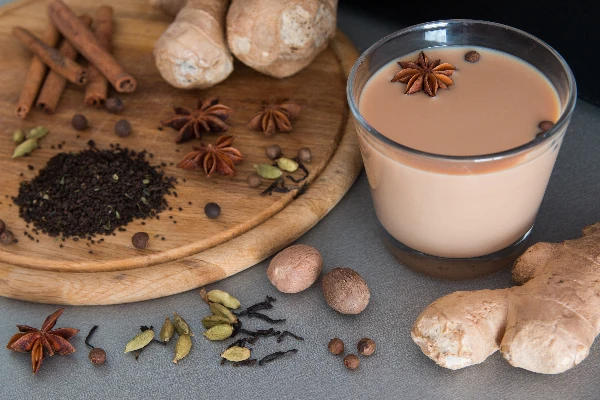
What are some variations of the traditional chai tea recipe?
Ah, the delightful symphony of spiced goodness that is chai tea! The perfect warming cuppa for any occasion. But you know what they say – variety is the spice of life. So, let’s dive into how to customise your traditional chai tea recipe like a pro.
You might think that chai tea is simply black tea with milk, sugar, and spices. Well, buckle up because the reality is much more flavoursome. There’s a world of variations out there to make your chai tea uniquely yours. Whether you’re lactose intolerant, avoiding sugar, craving a unique twist, or just exploring, there are loads of magical customisations you can experiment with.
How can you make a dairy-free chai tea?
Going dairy-free doesn’t mean you have to miss out on the creamy delight of chai tea. In fact, there are several plant-based milk alternatives that not only do the trick but add their own splash of flavour.
- Almond Milk: Light and nutty, it’s a great way to add a delicate flavour.
- Coconut Milk: Adds richness and a sweet, tropical twist.
- Oat Milk: Creamy with a subtle sweetness, often my go-to.
- Soy Milk: Thick and creamy, it’s a classic dairy alternative.
- Cashew Milk: Smooth and silky, it’s a match made in chai heaven.
Believe it or not, some might argue that these plant-based options taste even better than regular milk – bold statement, I know. Don’t knock it till you try it.
What are some popular sugar substitutes for chai tea?
Ah, sugar, the sweet villain in our storyline. But, if you want to keep it sweet without traditional sugar, fear not. You have options.
- Honey: Naturally sweet and adds a slightly floral note.
- Agave Syrup: Mild and sweet without overpowering the spices.
- Maple Syrup: Adds a rich, comforting sweetness.
- Stevia: Zero-calorie, all-natural sweetener for those watching their waistlines.
- Coconut Sugar: A hint of caramel flavour that pairs beautifully with chai spices.
While substituting sugar, it’s all about finding the balance that satisfies your sweet tooth without overshadowing the complex flavours of your spices.
How can you incorporate additional spices into your chai tea?
Spices – the heart and soul of chai tea. Naturally, the more, the merrier! You can actually play mix-and-match with the spices to create an even more tantalising chai experience.
- Turmeric: Earthy and slightly bitter, adds a vibrant yellow hue.
- Star Anise: Sweet and licorice-like, perfect for adventurous taste buds.
- Peppercorns: Adds a nice kick and warmth.
- Vanilla: Smooth and sweet, vanilla makes everything better.
- Nutmeg: Sweet and nutty, ideal for a cosy touch.
You see, there’s no strict rule book. It’s your canvas, so unleash your inner spice artist. Just be mindful not to add too many at once to avoid a flavour clash.
Customising your chai tea recipe opens the door to a delightful world of flavours. Next time you’re brewing a pot, go ahead and swap out the milk for some creamy oat milk, sweeten it with a touch of maple syrup, and toss in a few peppercorns for some zing. Your taste buds will thank you.
Once upon a time, in 1830s India, the first British-owned tea plantations were founded in Assam. The indigenous people were asked to cultivate Camellia sinensis plants which brewed Western-style tea.
Little did anyone know that these same plants would be transformed by Indian customs into what we now savour as chai. The British Empire might’ve got the tea-plant ball rolling, but the magic of chai – with its complex spices and vibrant flavours – is purely an Indian affair. Now that’s a tasty bit of history!
What is the nutritional information of chai tea?
Ah, chai tea—the soul-warming, spice-infused beverage that’s as comforting as a cosy blanket on a cold day. But let’s talk about what’s really in it, shall we? From calories to fat to vitamins, chai tea’s got a bit of everything. It’s not just a treat for your taste buds but also packs a punch when it comes to nutrition.
Chai tea, by its very name, signifies a blend of strong black tea, aromatic spices like cinnamon, cardamom, cloves, ginger, and a dash of sweetness, usually sugar or honey. Then, it’s tempered with milk, making it creamy and luscious. Naturally, what’s inside will vary based on how it’s prepared—so let’s break it down for you.
How many calories are in a typical serving of chai tea?
Right, you’re probably curious about the caloric damage of indulging in this little pleasure.
- A standard cup of chai tea usually clocks in at around 120 calories.
- These calories come from various sources, including the milk, sweetener, and even the spices to a small extent.
- If you opt for non-fat milk or a plant-based alternative like almond milk, you’ll be looking at fewer calories, hovering around the 60-90 calorie mark.
- Add a bit more sugar, and you’re looking at an additional 10-15 calories per teaspoon.
So, essentially, your calories are as customisable as the drink itself.
Let me give you some more examples.
| Preparation Method | Ingredients | Serving Size | Calories per Serving |
|---|---|---|---|
| Traditional Chai Tea | Black tea, whole milk, sugar | 1 cup | 200 |
| Chai Tea with Skim Milk and Sugar | Black tea, skim milk, sugar | 1 cup | 120 |
| Chai Tea with Almond Milk and Honey | Black tea, almond milk, honey | 1 cup | 90 |
| Chai Tea Latte (Cafe Style) | Chai tea concentrate, steamed milk | 1 cup | 180 |
| Masala Chai (Spiced) | Black tea, whole milk, sugar, spices | 1 cup | 210 |
| Chai Tea with Soy Milk and Stevia | Black tea, soy milk, stevia | 1 cup | 70 |
| Instant Chai Tea Mix | Powdered chai mix, hot water | 1 cup | 120 |
What is the fat content of chai tea with whole milk?
Onto the fatty bits—yes, it’s not all fun and spices, folks.
- Whole milk in chai tea can contribute around 6-8 grams of fat per cup, which includes about 4-5 grams of saturated fat.
- Switch to 2% milk, and you smack down the fat content to about 4.5 grams per serving, less than half of which is saturated fat.
- If you’re feeling adventurous and choose a non-dairy alternative, the fat content can range from negligible (like in almond milk) to moderate (like in coconut milk).
So, the cup you choose determines your destiny—fat-wise, at least.
Are there any vitamins and minerals in chai tea?
Yes indeed, the good news doesn’t end here. Chai tea isn’t just a delightful concoction; it’s loaded with some health perks thanks to its ingredients.
- Black tea leaves are the unsung heroes, providing antioxidants like polyphenols which combat free radicals.
- Cinnamon, cardamom, and cloves aren’t just for flavour; they also add small amounts of vitamins A and C.
- Milk or milk alternatives generally contain calcium, helping keep your bones strong.
- Chai spices like ginger and black pepper come packed with minerals such as magnesium and potassium.
So, it turns out this isn’t just a comfort drink; it’s giving you a health boost too.
Back in the day, Indian masala chai, the progenitor of our beloved chai tea, wasn’t just about sipping deliciousness. Legend has it that during World War II, tea, milk, and sugar were rationed in Britain.
So, the British Indian Tea Association decided to promote a milkier, spicier version of tea that used fewer tea leaves and more local spices to maximise resources. Well, they might’ve been forced into it, but this fusion drink ended up becoming a global favourite, continuing to charm us to this day.
So, next time you snuggle up with your chai tea, remember it’s not just a beverage—it’s a rich, historical blend that carries stories and nutrients in every sip. Cheers to that!
How can you adjust the chai tea recipe for different tastes and dietary needs?
Chai tea is a delightful blend of spices, tea, and milk that can be tailored to satisfy every palate and dietary requirement. Whether you prefer it creamy, sugar-free, decaffeinated, or robust, there’s a way to tweak the classic chai tea recipe. Modifying the ingredients allows you to enjoy your cuppa without compromising your health or taste preferences.
How can you make a vegan chai tea?
Good news, my plant-based friend! You can veganise chai tea without diminishing its rich flavours. The major culprit in traditional chai that’s not animal-friendly is milk. Swap it out, and voilà, you’ve got vegan chai.
- Plant-based milk options: Use almond milk, coconut milk, soy milk, or oat milk. Each adds its unique twist.
- Dairy-free whipped cream: If you like a bit of decadence, you can top it with coconut or almond-based whipped cream.
- Sweeteners: Replace honey with maple syrup, agave nectar, or date syrup for plant-based sweetness.
- Vegan-friendly teas: Ensure your tea leaves or bag brands don’t use animal products in their processing.
With these simple swaps, your vegan chai will be just as creamy and soulful as the original.
What are some low-sugar alternatives for chai tea?
So, you’ve decided to cut down on the sugar, eh? Don’t fret. You can still enjoy a sweet, satisfying cup of chai tea that won’t give you a sugar crash.
- Stevia: This plant-based sweetener is a great zero-calorie option.
- Monk fruit sweetener: Another natural, calorie-free alternative.
- Unsweetened vanilla almond milk: Adds a hint of sweetness without the sugar overload.
- Cinnamon and vanilla: Amplify these spices. They can give a naturally sweet taste, which reduces the need for added sugar.
- Erythritol: A sugar alcohol that tastes like sugar but without the calories or blood sugar spikes.
By switching to these alternatives, you get to enjoy the chai without the guilt and the post-caffeine sugar blues.
How can you make a caffeine-free chai tea?
Chai without the jitters is entirely possible and just as lovely. Whether you’re caffeine-sensitive or avoiding it late in the day, you can still savour the spiced richness.
- Rooibos tea: This South African herbal tea is naturally caffeine-free and pairs wonderfully with chai spices.
- Herbal chai blends: Many brands offer pre-made caffeine-free chai teas using ingredients like rooibos, chamomile, or honeybush.
- Decaffeinated black tea: If you love traditional chai but want to lose the caffeine, decaf black tea is your go-to.
- Spice-only chai: Skip the tea entirely and brew a blend of spices like cinnamon, ginger, and cardamom for a soothing, aromatic drink.
You can relish your caffeine-free chai anytime without worrying about staying up all night.
Once upon a cosy tearoom in Victorian England, tea master Sir Thomas Lipton brought international tea blends to the British masses. He notably experimented with various spices and herbs, influencing today’s chai tea variations.
Lipton’s legacy reminds us that the essence of enjoying tea lies in its flexibility and adaptability. From dairy-free to sugarless and caffeine-free options, there’s a delectable chai tea for everyone, tailored to taste and dietary needs.
What are some common mistakes to avoid when making chai tea?
Let’s talk about chai tea. Ah, the delightful brew that makes you feel warm and fuzzy inside. You might already be a connoisseur or just a chai-curious newbie, but either way, there are some common blunders you’ll want to avoid to nail that perfect cup. You see, crafting a marvellous chai isn’t rocket science, but even a misplaced cumin seed can turn your aromatic delight into a culinary calamity.
Consider over-boiling the tea as the number one enemy of a good chai. Picture it: you’re engrossed in the latest Netflix binge, and your chai is bubbling away, transforming from liquid gold to something that resembles a swamp creature’s bathwater.
Secondly, there’s the menace of low-quality spices. Using flavourless cinnamon sticks or expired cloves is a recipe for meh, rather than marvellous. And let’s not even get started on incorrect spice proportions – too much ginger can make it taste like you’re drinking spicy lava, while too little cardamom means you’re essentially sipping on hot, sugary milk.
Bad straining leaves you with a muck-filled bottom of your cup, and an incorrect serving temperature will leave you disappointed. Now, let’s dive into the specifics.
Why is over-boiling the tea a mistake?
Over-boiling the tea is like sending a love letter and then forgetting to hit ‘send’. The magic is lost. When you over-boil, the delicate tea leaves turn bitter and unattractive, much like that ex you’d rather forget.
- Loss of flavour: Boiling it too long extracts tannins, making your tea astringent and lacking in depth.
- Weakened aroma: Those intoxicating scents you’re after? They’re just gone.
- Nutrient loss: Heating the tea to death can rob it of those wonderful antioxidants.
- Murky appearance: Over-boiled tea is the visual equivalent of murky swamp water. No one wants to drink that.
- Overpowering spices: If you’re boiling the spices too, you’ll turn that balance into chaos.
Just keep an eye on your pot, and don’t abandon it for a quick scroll through Instagram. A boil of 2-3 minutes should do the trick.
How does using low-quality spices affect the flavour?
Okay, here’s the deal: using low-quality spices in your chai is like dressing up in a fancy suit but forgetting to comb your hair. Sure, you’ve got the basics, but the details mess it all up.
- Weak flavour: Low-quality spices basically say “meh” to your taste buds.
- Inconsistent taste: One cup might be okay-ish, the next a bland mess.
- Lack of aroma: You want your chai to make an olfactory statement when you walk into the kitchen, right? Well, good luck with that if your spices are subpar.
- Colour: High-quality, fresh spices not only taste better but often lend a more appealing colour to your tea.
- Health benefits: Fresh spices pack a punch in terms of health benefits compared to their lacklustre counterparts.
Invest in good spices. Your palate will thank you, and your nose will applaud the effort.
What is the correct way to strain chai tea?
Straining chai tea might seem like a no-brainer, but folks still manage to turn it into a fine mess. Imagine sipping your tea and getting a noseful of tea leaves and spices. Not cool.
- Use a fine-mesh strainer: Avoid chunks floating around by investing in a good strainer.
- Strain twice if needed: If your first pass still looks like a chunky soup, strain it again.
- Avoid over-pouring: Tip your kettle slowly; don’t rush it.
- Use cheesecloth for extra filtration: If you’re super picky or brewing a large batch, wrap your spices in cheese cloth for easy removal.
- Consider a tea infuser: It’s handy for those who loathe straining altogether.
Taking a moment to strain correctly will save you from the horrors of ‘spicy sludge at the bottom of the cup’ syndrome.
In medieval China, tea-making was an art form celebrated by none other than Emperor Shennong. Legend has it that Shen Nong discovered tea when a leaf accidentally fell into his boiling water.
This happy accident turned into an elaborate ritual that eventually morphed into the sophisticated tea culture we know today. Attention to detail was key, and that’s something you should consider when crafting your chai.
A perfect cup is not about shortcuts but about savouring the process – just as the Emperor would have.
Now that you’re armed with this wisdom, go forth and brew with confidence. Just remember, avoid the common pitfalls, and your chai tea will be nothing short of legendary!
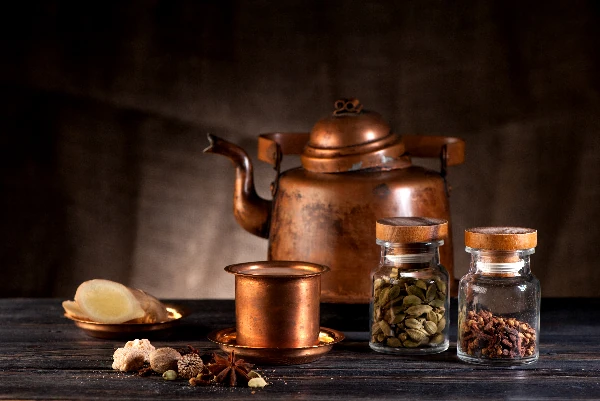
How does the cultural significance of chai tea influence its preparation and consumption?
Ah, chai tea. It’s not just a drink; it’s a lifestyle in a cup. This spiced brew has seeped into the fabric of Indian culture, making it more than just a beverage. It’s an experience. From social gatherings to traditional remedies, chai tea holds a special place. And trust me, once you dive into this aromatic world, you’ll never look at a simple cuppa the same way again.
In India, chai tea isn’t just consumed; it’s savoured, discussed, and shared. This drink brings people together. Whether at a bustling street corner or a quiet home, chai is the social lubricant that fuels conversations. Its preparation and consumption are art forms influenced by history, customs, and even geography. So, let’s unwrap this fascinating brew.
What role does chai tea play in Indian culture?
First off, chai tea is the ultimate social glue. It brings people together like a moth to a flame.
- In Indian households, no visit is complete without a steaming cup of chai.
- It’s the go-to offering for guests, showing hospitality and warmth.
- Street vendors, or ‘chaiwalas,’ create makeshift cafes at every corner, fostering community.
- Chai tea accompanies business meetings, friendly catch-ups, and even quiet moments of introspection.
- Festivals and celebrations often feature elaborate chai-making sessions.
Talk about versatility. Chai tea is seriously the Bridging Beverage. It breaks ice, seals deals, and comforts souls.
How is chai tea traditionally prepared in different regions of India?
When it comes to preparation, it’s a free-for-all. Every region adds its own flair, making each sip a versatile trip across the subcontinent.
- In Assam, robust black tea forms the basis, often brewed with milk and sugar.
- Kerala’s version often features cardamom, ginger, and even pepper for an extra zing.
- Up north in Kashmir, ‘Noon Chai’ or ‘Pink Tea’ includes bicarbonate of soda, giving it a unique rosy hue and salty taste.
- In Rajasthan, ‘Masala Chai’ often comes with a heavier dose of spices like cloves and cinnamon.
- Cities like Mumbai are famous for their ‘Cutting Chai,’ a smaller, stronger serving, perfect for an instant pick-me-up.
It’s like each region is a contestant in a chai-making contest, and honestly, everyone’s a winner.
How has chai tea been adapted in modern times?
With the rise of globalisation and café culture, chai has transformed, yet its soul remains intact.
- Chai lattes have taken Western coffee shops by storm.
- Instant chai blends offer convenience without losing the traditional taste.
- Gourmet versions, using exotic spices and ingredients, provide a luxurious twist.
- Health-conscious versions, such as low-sugar or dairy-free options, cater to evolving preferences.
- Ready-to-drink bottled chai brings the flavour to your doorstep, no brewing required.
It’s a classic case of ‘old meets new,’ showing adaptability while preserving essence.
Let’s end this with a spicy nugget from history. Back in the 1900s, the Indian Tea Association tried to popularise black tea among the local population. However, the frugal Indians had other ideas.
They started adding spices, milk, and sugar to stretch out the pricey tea leaves. What did we get? The invincible, delightfully customisable, masala chai. The colonial pushback inadvertently spurred an iconic tradition. Now that’s some food—or should I say, tea—for thought.
What are the health benefits of drinking chai tea?
Chai tea, a delightful blend of spices and black tea, isn’t just a beverage; it’s a health elixir disguised as your morning pick-me-up. From giving you a gentle nudge to start the day to making your taste buds dance with joy, chai tea packs a punch in more ways than one.
The health benefits? They read like a health enthusiast’s Christmas wish list—antioxidant properties, digestive champions, anti-inflammatory warriors, heart protectors, and mental well-being boosters. Let’s break these down, shall we?
What antioxidants are found in chai tea?
Antioxidants are the unsung heroes that keep our cells from going rogue and setting us on a path to age faster than a banana left out in the sun. In chai tea, the antioxidants come from both the black tea and the spices that make up this aromatic blend.
- Black Tea: Rich in polyphenols, substances that help reduce oxidative stress.
- Cinnamon: Packed with cinnamaldehyde, a powerful antioxidant.
- Ginger: Contains gingerol, an antimeric compound known for its antioxidant and anti-inflammatory effects.
- Cloves: These little wonders are chock-full of eugenol, another strong antioxidant.
- Cardamom: Houses various essential oils and flavenoids, giving it superfood status.
So, when you sip that chai, think of it as drinking a potion that battles many of those nasty free radicals contributing to ageing and diseases.
How does chai tea aid in digestion?
Who knew that your stomach’s BFF could come in a teapot? The spices in chai tea work in tandem to keep your digestive system in tip-top shape. Here’s how:
- Ginger: Known for its ability to soothe the stomach, reducing nausea and enhancing gastric motility.
- Cardamom: Acts as a digestive stimulant and diuretic, helping with all that post-meal bloat.
- Cinnamon: Improves the digestive process by increasing the production of digestive enzymes.
- Cloves: Enhance overall digestion by promoting the production of gastrointestinal juices.
- Black Pepper: Boosts the secretion of hydrochloric acid, making sure your food gets digested properly.
Your gut will thank you, and you can finally say goodbye to those uncomfortable post-meal food babies.
Can chai tea help reduce inflammation?
Inflammation might sound like an all-out internal brawl, and frankly, it is. Chronic inflammation is a gateway to numerous health issues, from arthritis to heart disease. Lucky for us, chai tea comes riding in with an army of anti-inflammatory properties.
- Ginger: Contains potent anti-inflammatory properties courtesy of the compound gingerol.
- Cinnamon: Has been shown to reduce specific markers of inflammation.
- Black Tea: Features theaflavins and thearubigins, both of which work against inflammation.
- Cloves: Eugenol strikes again, reducing inflammation and acting as a pain relief.
- Cardamom: Exhibits anti-inflammatory and immune-enhancing properties.
It’s almost like each cup of chai tea is an undercover anti-inflammatory assembly working to keep your body in balance.
Now, let’s transport ourselves to the Mughal era in India. Back in the day, Emperor Shah Jahan, the man behind the Taj Mahal, was known to drink chai tea to boost his health during long hours of ruling one of the most magnificent empires in history. Made with spices sourced from across his vast kingdom, it served not only as a refreshing drink but also as a soothing remedy to keep the emperor in prime condition while he was busy making history.
So, the next time someone spins you a yarn about their miraculous potion for good health, tell them to have a seat and serve them a cup of chai. The brew fit for an emperor!
Conclusion
In our exploration of mastering the perfect chai tea recipe, we’ve uncovered the essential ingredients that form the backbone of this beloved beverage, from the robust notes of black tea to the delicate balance of spices like cinnamon and cardamom. These elements not only enhance the flavour but also contribute to the rich cultural tapestry surrounding chai. Moreover, the preparation method, carefully broken down in our detailed table, proves that making chai at home can be both accessible and rewarding.
What I find particularly significant is how this simple drink transcends mere sustenance; it serves as a bridge between cultures, uniting people during social gatherings and imparting a sense of tradition. From variations that cater to different diets—be it vegan, dairy-free, or low-sugar—to the intriguing health benefits such as antioxidants and digestive aids, chai tea resonates deeply with those who seek comfort and wellness in a cup.
As we consider the common pitfalls to avoid and reflect on the cultural significance of chai, it becomes clear that there is much room for creativity and personal adaptation. So, whether you are enjoying a traditional cup or experimenting with new twists, I invite you to take this knowledge and make it your own.
To wrap up, I leave you with a thought: every sip of chai not only delights the taste buds but also connects you to a broader narrative of cultural heritage and personal expression. How will you write your own story with chai tea?


